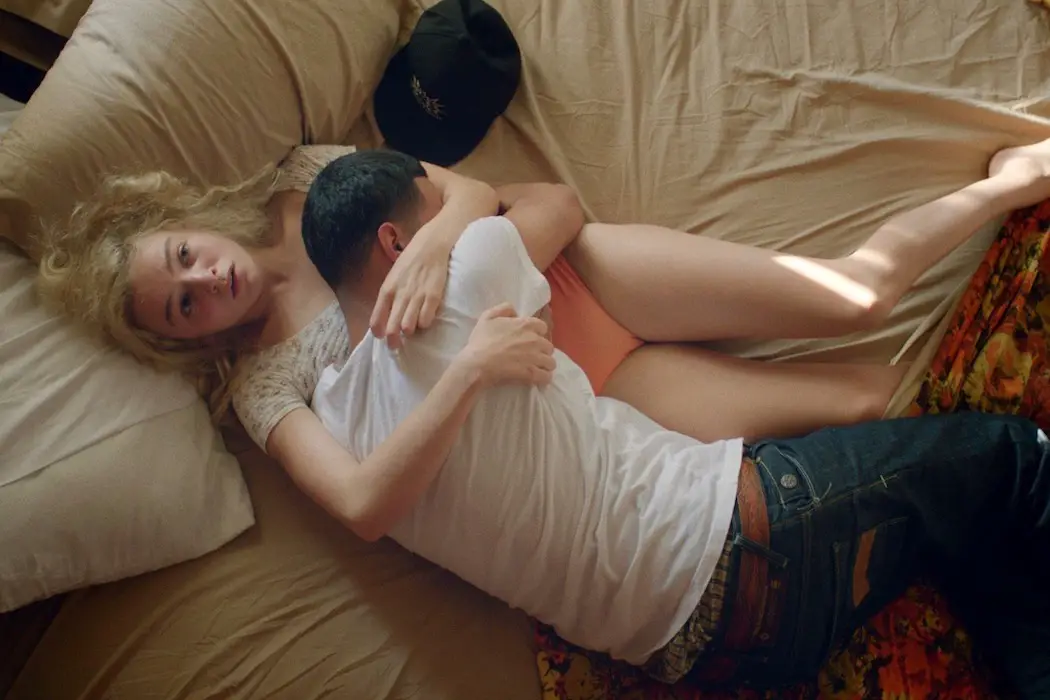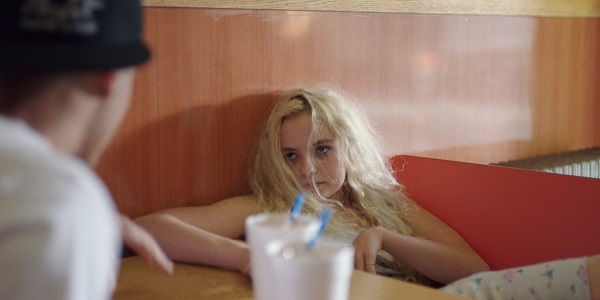“Have You Ever Seen A Real Woman Before?” Body Imagery In WHITE GIRL

Sophia Cowley is a young writer, yogi, feminist and film…
First-time filmmaker, Elizabeth Wood recently made a film that has people talking. Vice even compared it to Larry Clark‘s 1995 film, Kids. The film is White Girl, a coming-of-age drama/thriller about a 19-year-old named Leah (played by Morgan Saylor), who gets caught up in a drug-deal gone wrong and winds up bailing her friend out of jail. As the audience, we glimpse into the ceaseless and indulgent privilege that comes with being young and white in an increasingly gentrified New York City.
The film took me back to when I was (very briefly) a student at a liberal arts school in upstate NY and would hear about kids who, as a joke, would wake their friend up in the morning by placing a bit of blow right under his nose. The difference here is that characters in White Girl club hop while kids at my old school go to frat parties.
For Ms. Wood, the story is personal, if not at least somewhat self-indulgent. She lived the life of the Midwestern-transplant-party-girl during her college days, when she moved into the largely Puerto-Rican neighborhood of Ridgewood, Queens. As Emma Brockes of The Guardian articulates, Wood was “safe in the knowledge she would have the option to one day move out.”
To be honest, I would rather hear the stories from her neighbors in Queens. Despite its obvious cultural and racial significance, I couldn’t help but see the film from an anatomical level, oddly enough. If you pay attention, there are quite a few shots of Leah with her face either covered or just out of frame.
The Rebel Body
Toward the beginning of the film, I was excited by Leah’s championing of her sexuality, and was ready to view the movie through a feminist lens. In fact, in one scene, one of Leah’s new neighbors points and laughs hysterically at her roommate’s hairy armpits. Leah’s roommate, Katie, sits back confidently and asks, “Have you ever seen a real woman before?”

Like Katie, Leah is (mostly) in control of her body and her sensuality; she sleeps with her love-interest, Blue, because she wants to. She’s a hedonist, but at least she’s calling the shots. At least, this is her M.O. for the first half of the film.
In the early sex scenes of the film, Leah appears alive and empowered, usually making the moves with her partners. I felt comfortable knowing that her character was owning her own sexuality. But later on, she becomes less of a rebel and more of a robot.
The Animal Body
Throughout White Girl, Leah is heavily sexualized, though mostly on her own accord. The depiction of her body on screen seems to reflect the unconscious desire to return to an animal-state once reality sets in. In the beginning of the film, she owns her body and her sexuality, choosing whom she has sex with and when. But as the film continues, she almost becomes a body, losing much of her personal identity to drugs, mindless choices and the corruption of a crumbling world around her.
In a later scene, when Leah finally makes enough money to pay for Blue’s lawyer, she celebrates in a drug-induced three-way. The whole scene, which takes place in the bathroom of a club, is framed by blurred edges, keeping our vision tunneled and increasingly hazy.

We see a shot of Leah’s belly; suddenly she becomes a disjointed body and we see only pieces of her. This is the moment where she becomes material, almost animalistic. We only see her face again once she passes out due to an overdose.
In another scene, Leah is animal-like in the sense that she is helpless, victimized. After she meets with the lawyer, to discuss Blue’s case over dinner, he rapes her while she is passed out on the couch. Again, Leah is an expression of the body, this time not by her own free will.
Body Genres
Feminist film critic, Linda Williams, describes a similar phenomenon in her essay, “Film Bodies.” According to Williams, who quotes fellow critic and film studies professor, Carol Clover, the “Body Genre” encompasses a type of film that “privileges the sensational.” One obvious example is pornography, where seeing a woman’s body in the throws of ecstasy is commonplace.

Williams also discusses the notion of excess in regards to body genres, stating how a female character in a body film will experience extreme pleasure, fear or pain at several points throughout the film. How the character embodies this excess, and how that emotion is consequentially felt in the bodies of the audience members, defines the body genre as well.
To call White Girl a body film is not to necessarily call it pornographic, although Leah and her body are pretty well exposed, to say the least. We see Leah move her body (while dancing at parties or night clubs and while having sex); we see her put substances into her body (i.e. coke) and we see her process emotions through her body (when she breaks down in front of her boss, and again with Blue’s attorney).
But as Leah becomes increasingly inebriated throughout the course of the film, her drug-induced emotional numbing transcribes into her physical body. She becomes less “sensational” and more stagnant. To me, this is the most gruesome part; watching her move from energetic to literally unconscious at points is pretty horrifying.
Conclusion
Overall, White Girl reflects the embodiment of societal and interpersonal dysfunction. And Leah’s expression of personal angst makes her a poster child of reversion to a pre-conscious state of being.
Leah gets trapped in the animalistic world of drugs and dancing, swept up in the whirlwind of being young in New York. She is a hedonistic woman driven by instinct and desire, whose choices whether conscious or unconscious, often come at a high price. Leah is neither victim nor perpetrator, but seems to fall somewhere in between.
Do you feel that Leah in White Girl accurately portrays what it means to be young and privileged today?
White Girl is available on Netflix.
Does content like this matter to you?
Become a Member and support film journalism. Unlock access to all of Film Inquiry`s great articles. Join a community of like-minded readers who are passionate about cinema - get access to our private members Network, give back to independent filmmakers, and more.
Sophia Cowley is a young writer, yogi, feminist and film enthusiast from NY. Her idols include Miranda July, David Lynch and Abraham Lincoln. She runs the blog www. isthisthereellife.wordpress.com.













